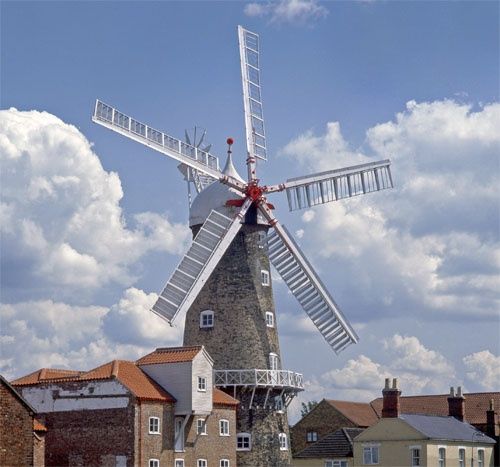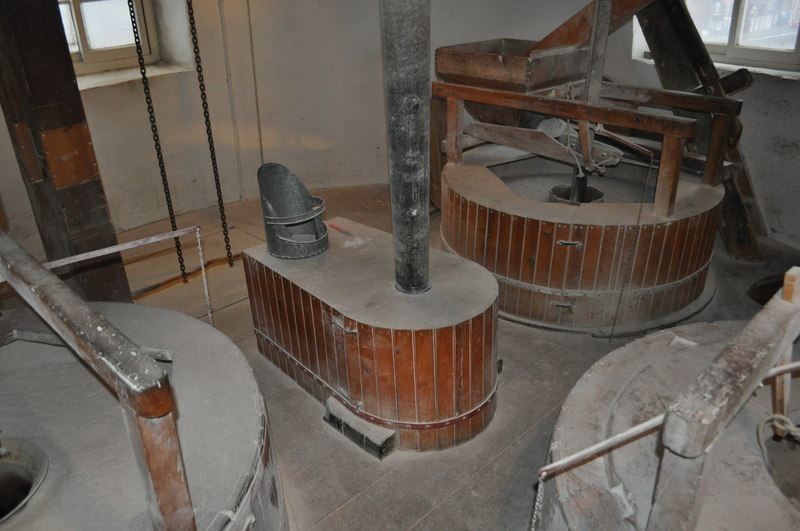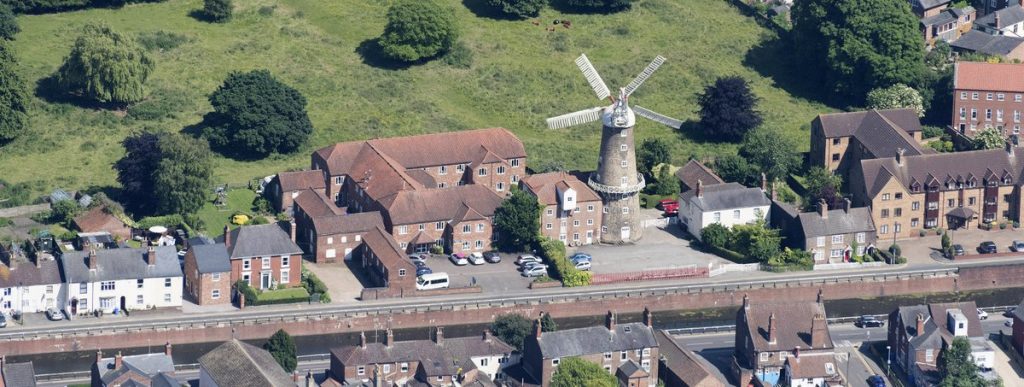This fine example of an English tower mill was built in 1819 for the brothers Thomas and Isaac Reckitt by the Hull millwrights Norman and Smithson, for the sum of £1,826 – 10s – 6d. Remarkably, the original contracts from the building of the mill still survive.
THE BASICS
- The sails of the windmill must face into the wind at all times in order to work.
- The windmill’s five sails are attached to the cap – the timber-framed top of the mill.
- The fantail turns the cap automatically to face the sails into the wind.
- All the milling machinery is contained in the stationary brick tower, which has seven floors.

THE MILL FROM TOP TO BOTTOM
The brick tower of the mill is 64ft (19.5m) tall. The height of the mill to the finial on top of the cap is just over 80ft (24.4m). This makes Maud Foster mill the tallest working windmill in the country.
The sails are fixed to a stout iron cross which is fixed to the front end of the iron windshaft. The speed of the sails are controlled with the aid of a rope and a chain which can be reached from the balcony.
The brake wheel, mounted on the windshaft, drives the crown wheel (at the top of the central upright shaft.

Near the bottom of the upright shaft is the spur wheel . This large wheel transmits power to each of the three stone nuts which drive each pair of millstones. In each pair, only the upper or runner stone rotates – the lower or bed stone remains stationary. A very fine working gap between the stones causes the grains to be cut open to release the particles inside. Two of the pairs of millstones are Derbyshire Grey stones, a sandstone found in the Peak District. The other pair are of French Burr, a hard quartz quarried in the Paris Basin.
The sack hoist at the top of the mill lifts sacks of grain from the ground floor to the top, ready for milling. Grain is stored in large storage bins and fed into the millstones by gravity, emerging through a spout on the balcony floor as ‘wholemeal’ flour.
Once it has passed between the millstones, the wholemeal flour is sieved and graded by the Dressing Machine on the 2nd floor to produce white flour, semolina, sharps and bran. Each of these grades can be purchased in the mill shop.
The Roller Mill is situated on the first floor and is used for producing flaked grains for products such as muesli. The machine is very simple, having two heavy iron rollers that can be screwed together to provide the pressure to crush the grain.
There are two mixing machines on the ground floor, one for flour and one for grain. These are used for blending different products together.
The machine at the back of the ground floor is the Hurst Frame, whose electrically powered grey stones are used on days when there is not sufficient wind to drive the sails.
THE MILL SHOP
The shop sells stoneground flour, porridge oats, local history books and a variety of very good quality souvenirs. Four is sold in 500g, 1Kg and 6Kg bags which are always available. 16Kg and 32Kg sacks of flour can be ordered in advance for collection from the Mill.
Distance from The Carpenters Arms Hotel: By Car: 5 Min Drive – On Foot: 15 Min Walk

